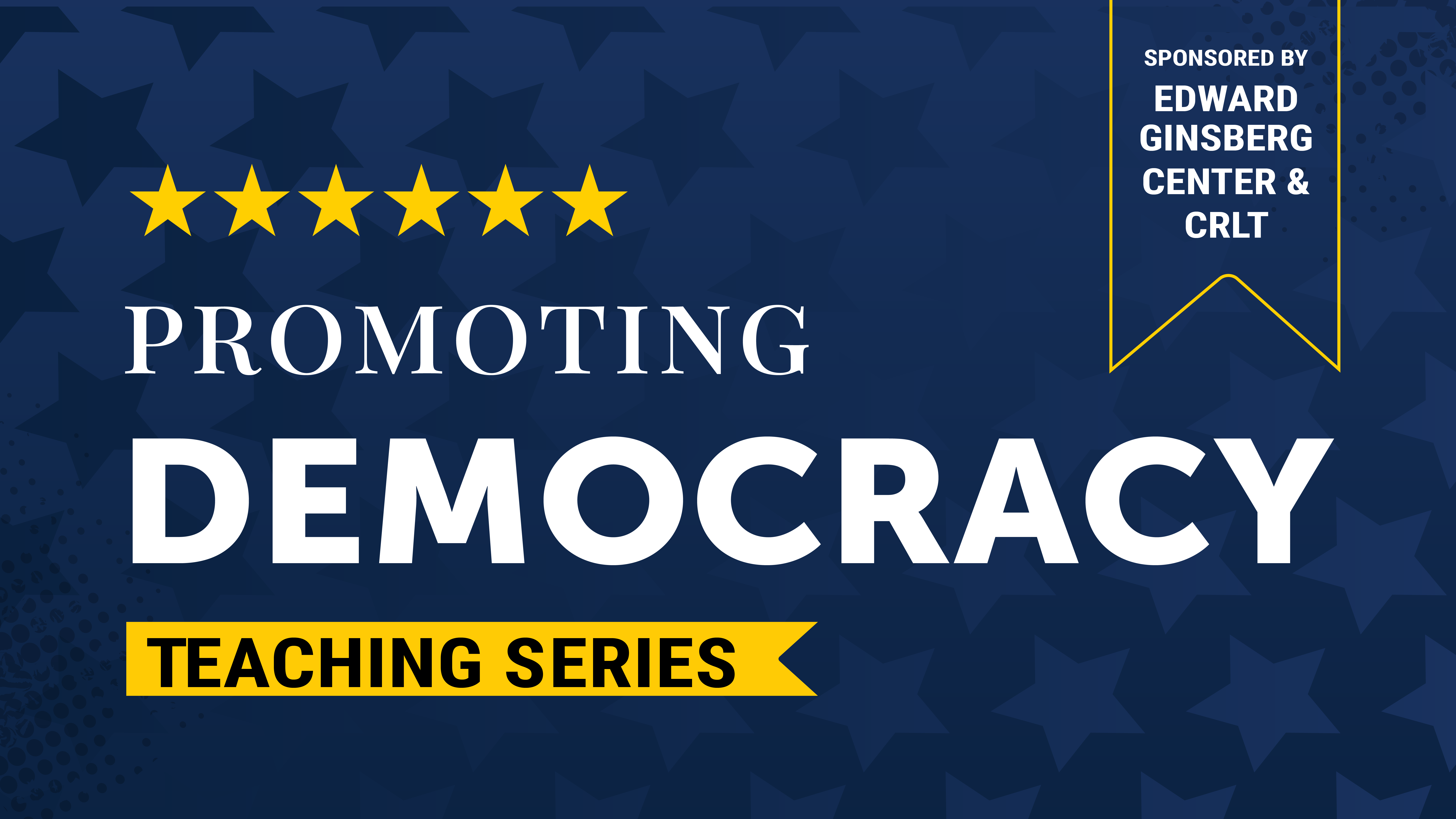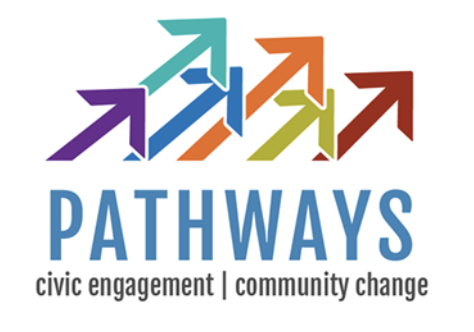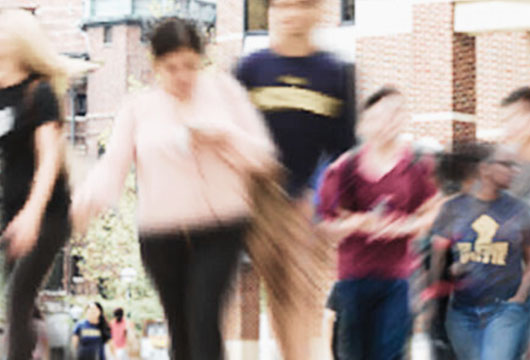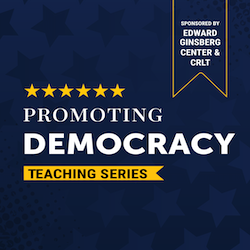
This piece is part of CRLT and the Edward Ginsberg Center's partnership to offer programming and resources for instructors around democratic and civic engagement through the Promoting Democracy Teaching Series.
Instructors preparing to teach during the post-election period face a complex task that requires thoughtful preparation. To start, it is hard to anticipate how long the post-election period will last or how central it will be to public discourse. We may find ourselves with clear winners of major races on election night, in a short period of uncertainty as votes are processed and counted, or in a drawn-out post-election scenario, as results in key races are contested or litigated.
Adding to the complexity, the events following election day will impact our students differently. Regardless of the outcome of major elections, some of our students will be disappointed. Moreover, the extent to which students are directly impacted by election outcomes—or by the heightened rhetoric of a prolonged post-election period—will vary depending on their identities, positionality, and individual circumstances.
No matter where we find ourselves on November 6th, it’s safe to assume that our students will be learning in tumultuous times, and some will be experiencing heightened stress and strong emotions. In addition, for many of our students, this election will have been one of their first voting experiences. This post-election period may be important to their long-term democratic and civic engagement, and we can support them as they interpret post-election events and information, consider their implications, and reflect on the future of their civic engagement.
As you support your students in this moment and navigate this teaching moment, consultants at CRLT and Ginsberg Center are available to talk with you about planning courses or class sessions. You can request a consultation with CRLT or use Ginsberg Center’s Support Request Form.
Key Considerations for Your Post-Election Approach
Throughout our work this election season, we have highlighted that teaching during an election season can be both a challenge and an opportunity to help our students feel prepared and motivated to participate in our democracy. Admittedly, at this point in the semester and at this point in a long and intense election season, it may feel more like a challenge than an opportunity. We encourage you to start by reflecting on your own capacity and context to build an approach that’s right for you.
The Center for Teaching Excellence at Boston College lays out a useful set of factors that instructors may want to reflect on as you plan your response that include:
- Your own response and comfort level. Just like our students, the events, rhetoric, and outcomes of this election season have a direct impact on us. Like our students, the effects will be different, based on our identities, positionality, personal experiences, and political beliefs. As you reflect, it is understandable and reasonable that your own wellbeing moves you towards some options over others.
- Student Burnout. You may have a sense already of whether your students are interested in engaging with post-election events or are experiencing burnout, but remember that you can also ask. Consider asking through an anonymous poll, survey, or querying students over email, as students feel hesitant to break from their classmates. You might also choose to make a class session or learning experience optional.
- Classroom community. As you consider your options for the post-election, particularly whether you’ll facilitate classroom discussion around election topics, it’s important to consider whether students have a foundation with each other and with the instructional team for having these discussions. Well-established discussion guidelines and experience with productive high-stakes discussions may have laid this groundwork.
With these considerations in mind, you can pursue specific strategies and approaches that seem promising. The options we outline below are not mutually exclusive—you can choose how many or few to implement based on what best supports you, your classroom context and constraints, and the post-election scenario we find ourselves in.
Small Moves to Support Students in Tumultuous Times
Acknowledge what’s happening. One simple action we can take is to acknowledge the events taking place outside of the classroom and the effects they may be having on students (Huston & DiPietro 2007). While this gesture may seem small, it can communicate care and understanding to our students.
Make adjustments to support students’ learning. Research shows that anxiety and stress affect our students’ ability to focus, add to their cognitive load, and interfere with working memory (Eaton et al. 2023). Consider in advance where you can provide flexibility—such as extending a deadline or providing recordings of class sessions— and whether you want to make adjustments to your course plan to support student learning, such as slowing down the pace of material or providing additional opportunities for review. To help students make best use of any changes, be sure to communicate them to all students, rather than making decisions on a case-by-case basis.
Share university and community resources. Across campus, student support offices and student life organizations can provide space for students to process their reactions to election outcomes and post-election current events, connect with and find support in their communities, and manage stress. Encourage students to connect with the groups where they find affinity and community to process the election, whether they are student-run organizations, student life units, such as the Spectrum Center or Trotter Multicultural Center, or organizations in the greater community.
Counseling and Psychological Services (CAPS) has been especially proactive about supporting students after election day, with drop-in spaces to “Reflect and Connect” to cope with election stress and several guides for students coping with uncertainty or managing election related stress, in addition to their usual counseling services.
Preparing for Class Discussions Around the Post-Election
You may decide on an approach with dedicated class time to the election, whether this means a short reflection activity; a facilitated discussion to process, debrief, or share perspectives; or learning experiences around building civic skills for understanding and participating in this political moment.
With any in-class learning experience around high-stakes topics, we encourage instructors to start with our framework for facilitating election discussions. You may want to explore activities and structures well-suited for your discussion goals. For example, if your goals are around processing their own reactions and sharing perspectives, you may be looking for activities that provide time and space for students to think deeply and encourage active listening, such as reflective writing or a conversation cafe.
If students will be in discussion with each other, we encourage you to establish (or revisit existing) discussion ground rules or community agreements. Even with thoughtful planning and structures in place, discussions about the election may include sudden moments of tension, conflict, or big emotion. Identify a few strategies and practice some response language to prepare for these possibilities in our Facilitation Strategies for Hot Moments in the Election guide.
Dedicating Class Time to Understanding and Engaging with the Post-Election
In the event that there is a period between election day and a clear outcome, our students may naturally be wondering what’s going on and whether something has gone wrong. Like most of us, many students aren’t well-versed in what election officials do after the polls close. That is, the steps of processing, counting, reporting, canvassing, and certifying results. These steps ensure that the process is accurate and secure, but they also take time, particularly when an election is very close. Similarly, our students may not realize the variation in election laws across the states, which can explain why one swing state has reported an outcome, while another has not. The SLSV coalition’s 2024 Post-Election Campus Resource Guide brings together a number of resources that students can engage with to make sense of news after election day including:
- The U.S. Election Assistance Commission’s short series of 2-3 minute videos to explain “what happens after I vote?”
- The How Elections Work project’s fact sheets and infographics for the electoral process of each state. Students might particularly appreciate the Michigan fact sheet and infographic.
Your disciplinary context may also provide helpful insights to understanding these processes and why they were selected. While disciplines like history and political science may seem especially well-situated to these topics, instructors in other disciplines may find opportunities as well (e.g. Social Choice Theory in economics, the mathematics behind the Electoral College and apportionment, and the tradeoffs between republics and democracies in classical political philosophy). Faculty with expertise outside the U.S. cultural context may find that comparison of alternative political processes or cultural norms around political participation can help students understand the U.S. system better.
The civic skills of analyzing information and evaluating evidence may be particularly important in a prolonged post-election period, where we can expect the spread of misinformation. Your disciplinary context may prove a valuable lens here as well. You and your students might engage with questions like:
- How does our discipline draw conclusions about the accuracy and usefulness of information? Using these methods, what kinds of questions or conclusions might someone in our field draw about this piece of election-related information?
- Has our discipline or professionals in our field had to combat misinformation in the past? What strategies have they used? Do we see similar strategies now?
- What are our discipline’s theories for why false ideas spread?
You might also build a learning experience around the News Literacy Project’s Misinformation Dashboard: Election 2024 or around the guidance and resources included in U-M’s library’s guide "Fake News," Lies and Propaganda: How to Sort Fact from Fiction.”
Sharing Resources for Multiple Pathways for Civic Engagement and Community Change
Even if there are delays in election results or a period of uncertainty about what's happening next with election outcomes, instructors can provide valuable, non-partisan support by guiding students toward meaningful civic and community engagement as a constructive way to channel their energies. Students don’t have to wait for all the dust to settle to make contributions to the issues they care about—in fact, for some of our students, civic and community engagement will be an avenue for coping with stress during tumultuous events (Ballard et al. 2022; Huston and DiPietro 2007). We can remind students that civic engagement extends beyond voting to a set of lifelong habits we can cultivate and practice to support and create thriving communities.
 Pathways to Civic Engagement and Community Change is a framework that can help students think expansively about how they can continue to take action after election day and throughout their U-M experience. Consider sharing resources and ideas for action along all six Pathways:
Pathways to Civic Engagement and Community Change is a framework that can help students think expansively about how they can continue to take action after election day and throughout their U-M experience. Consider sharing resources and ideas for action along all six Pathways:
Policy & Governance - Participating in democratic political and deliberative processes, policymaking, and public governance:
- Share the schedule of local public meetings and encourage students to attend, view online, or read minutes.
- Encourage students to contact local and national elected officials in writing or in person around issues they care about related to your discipline, field, or course content.
Direct Service - Working to address the immediate needs of individuals or a community, often through direct interaction with the people or place being served:
- Offer a curated list of engagement opportunities pulled from one of the databases below:
- Connect2Community (for opportunities in Southeast Michigan),
- Volunteer Portal (for the state of Michigan) or
- VolunteerMatch (for opportunities across the US).
- Ask students to reflect on how they are making connections between their experiences in a community-engaged student organization, co-curricular program, or service-year program and their classroom learning.
Community-Engaged Learning and Research - Connecting coursework, academic research, and outside of the classroom experiences to community-identified concerns to enrich knowledge and inform action on social issues:
- Assist students in using research to support local community efforts related to your field or discipline - contact the Ginsberg Center for help finding a community partner and/or planning a project.
- Prepare your students to thoughtfully engage with communities.
Community Organizing & Activism - Involving, educating, and mobilizing individuals or groups to influence or persuade others toward attitude, policy, or culture change:
- Have students study a current or past social movement or community-led campaign related to your field and/or an issue they care about.
- Invite representatives from an action-oriented coalition on campus or in your community to speak with your class, department, or program.
Philanthropy - Donating or raising funds and resources for nonprofits and other non-governmental organizations that engage in work that contributes to the public good:
- Have students research local organizations that are related to course content and personal interests to support existing fundraising efforts or support new ones, such as donation drives for non-monetary items (clothes, materials, food, etc.).
- Encourage students to research different philanthropic efforts through sites such as GreatNonprofits, CharityNavigator, or the Philanthropic Initiative on Racial Equity.
Social Entrepreneurship - Using ethical business approaches to create or expand market-oriented responses to social or environmental problems and address the needs of underserved groups:
- Have students research existing efforts prior to proposing or creating new initiatives and identify the ways they can complement, enhance, or partner with these efforts.
- Share examples and research on how to maximize ethical practices (worker conditions, profit-sharing) as they explore social entrepreneurship
- Log in to post comments
- 6003 views






